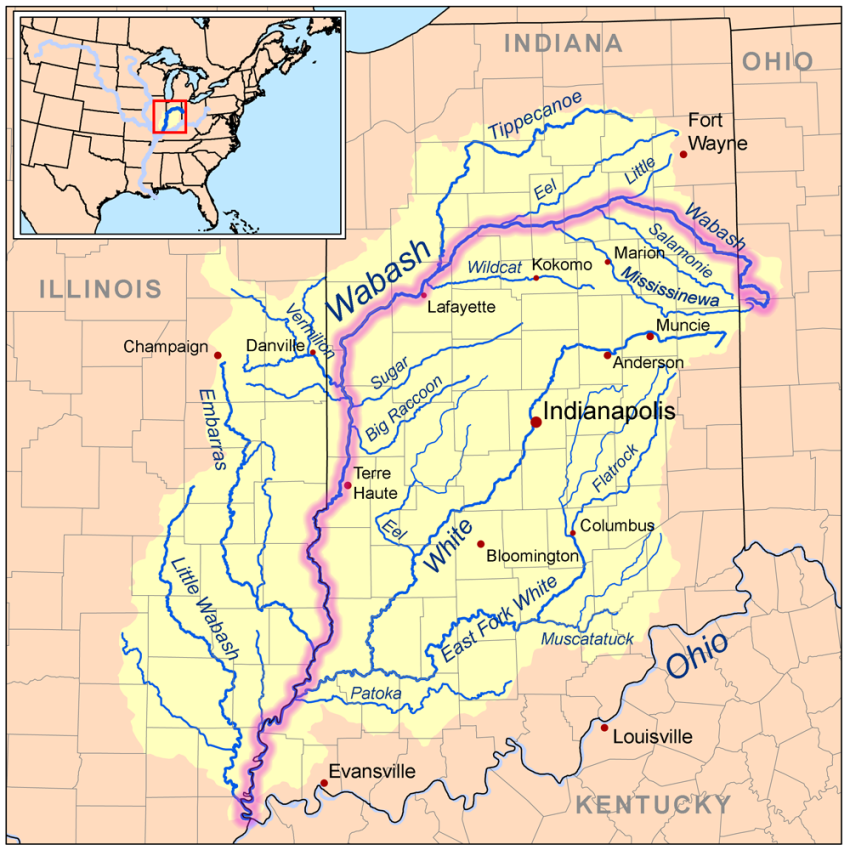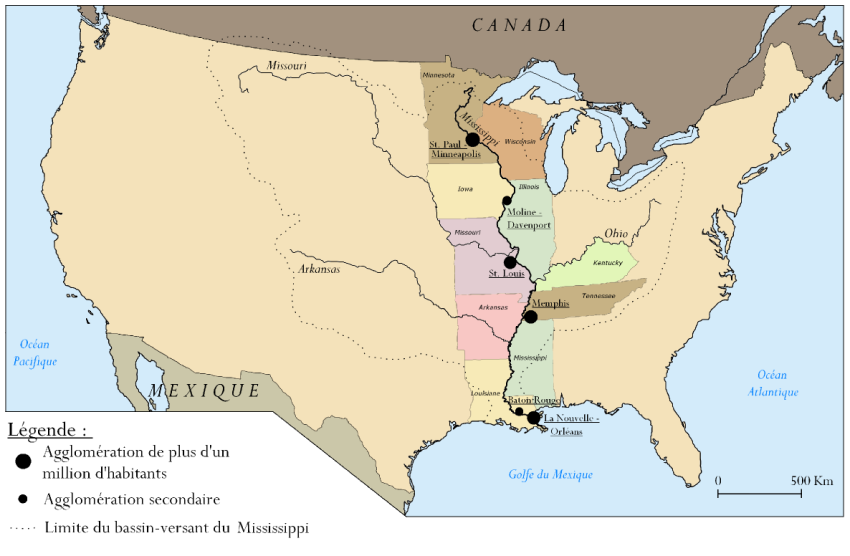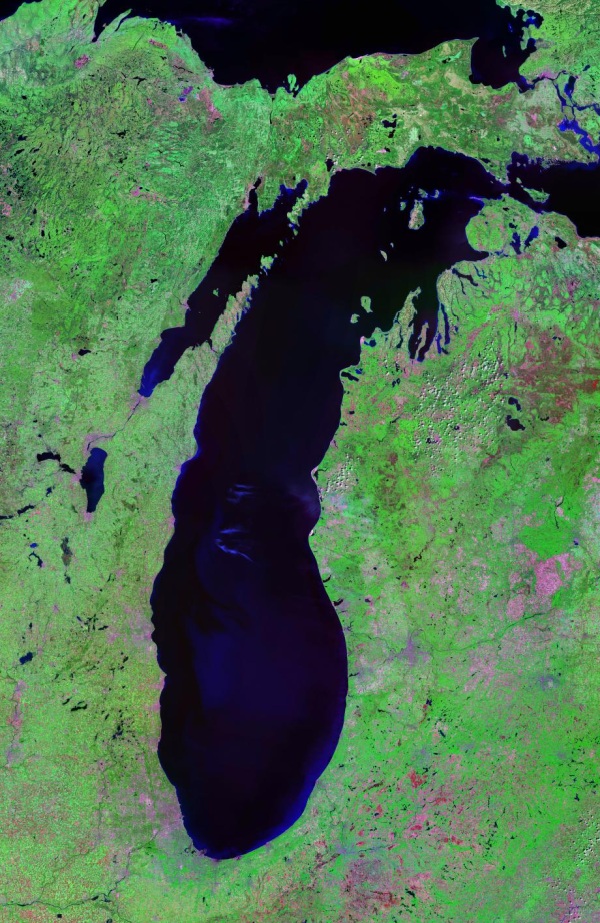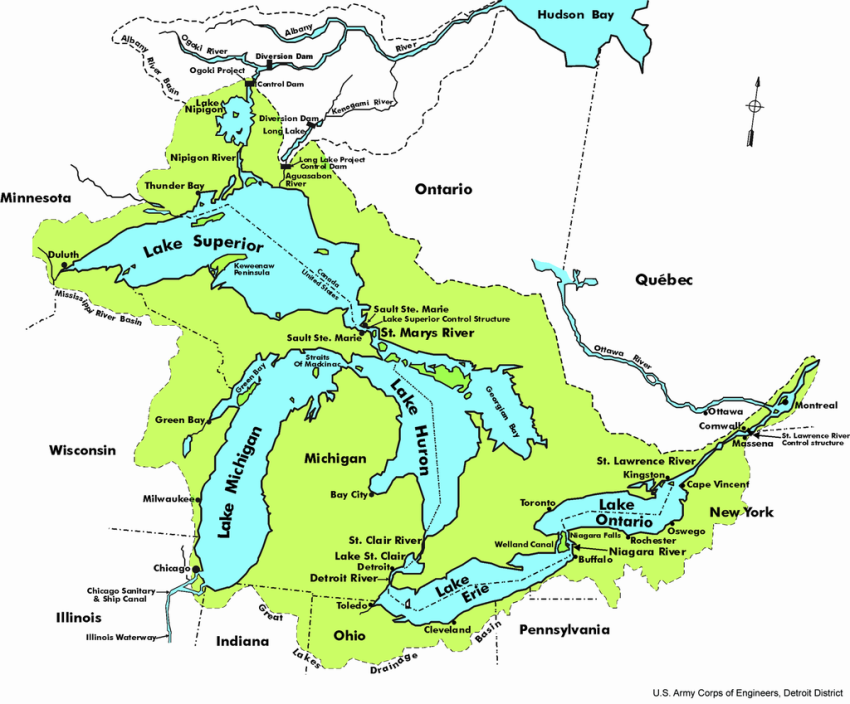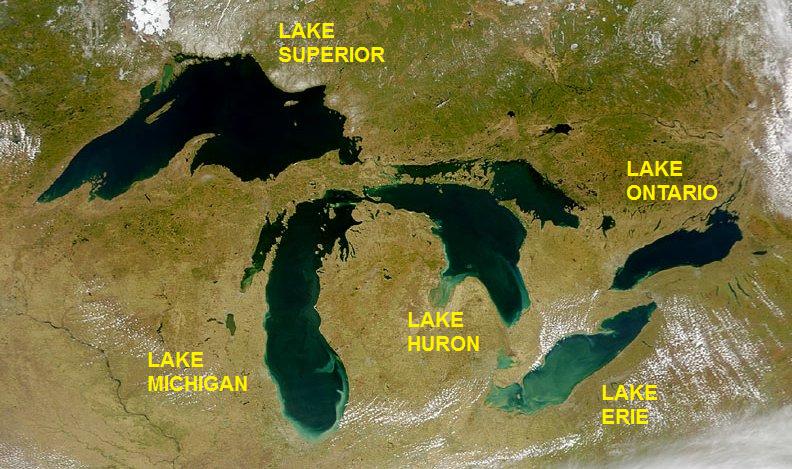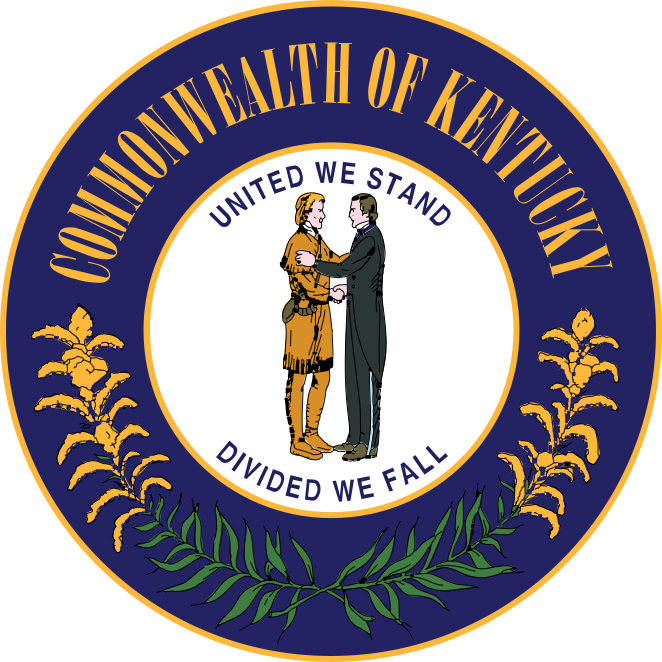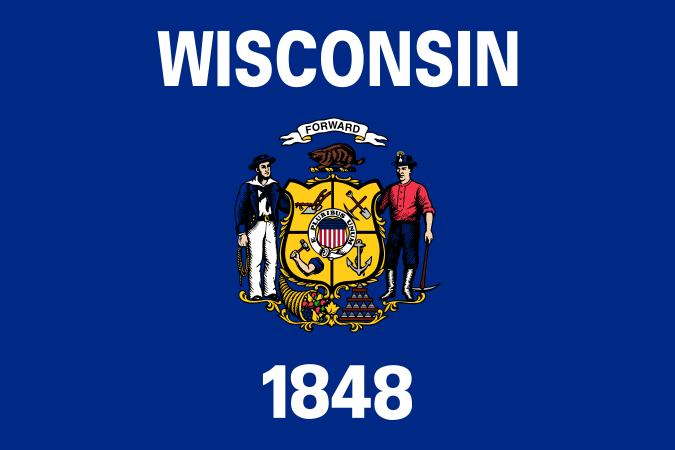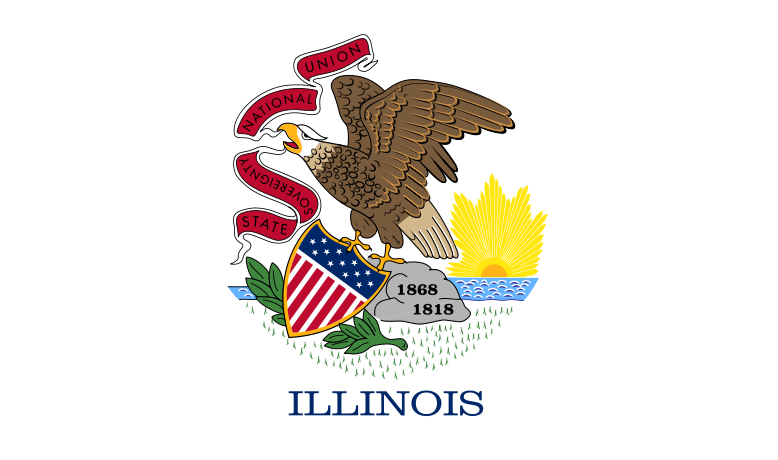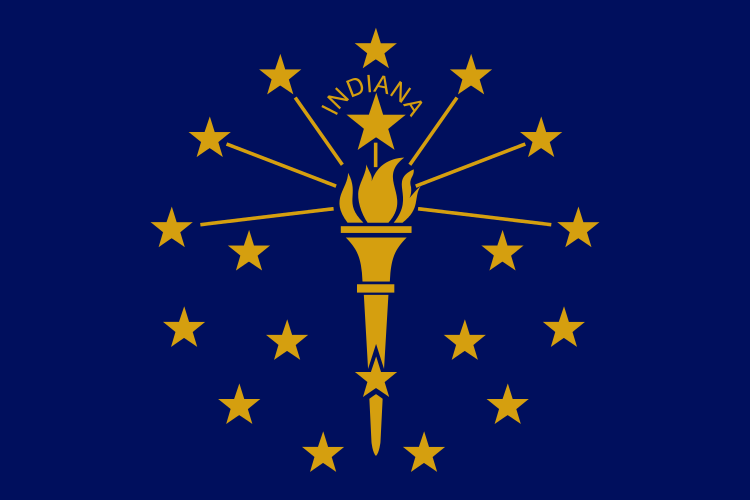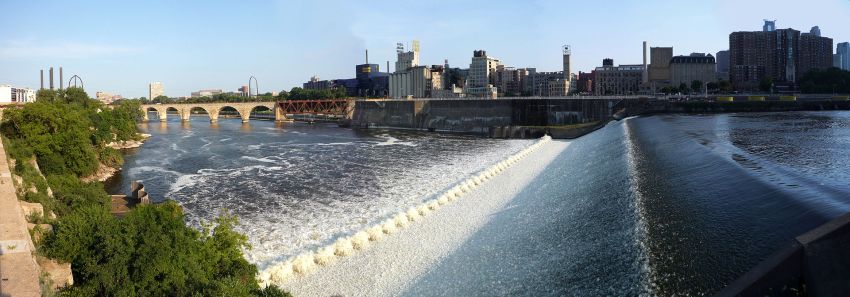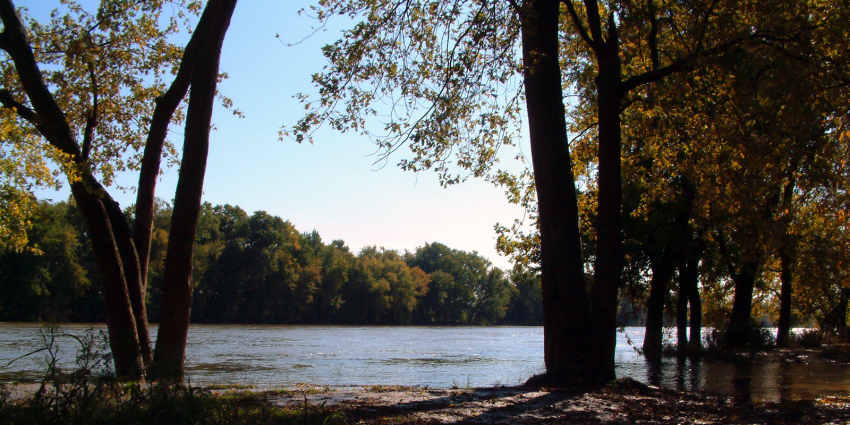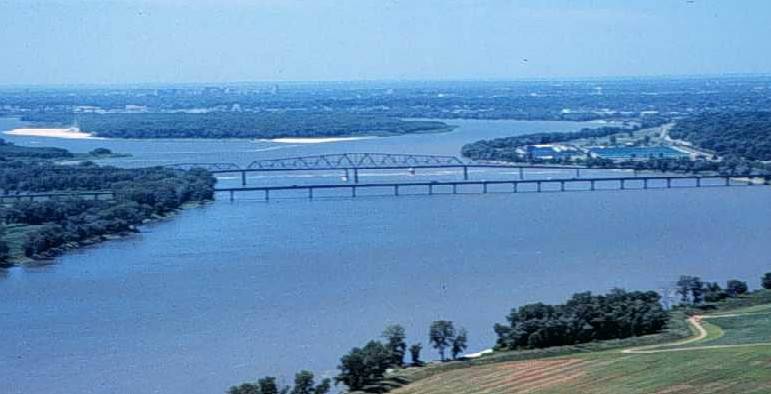GEOGRAFÍA
Indiana limita al norte con el lago Míchigan y con Míchigan, al este con Ohio, al sureste y al sur con Kentucky y al oeste con Illinois. Indiana es uno de los estados de los Grandes Lagos.
El río Wabash corta a Indiana por cerca de 650 kilómetros, en sentido nordeste-suroeste. Es un afluente del río Ohio, toda vez que afluente del río Misisipi. Lacuenca hidrográfica de éste último cubre la mayor parte del estado. El Wabash ha dado nombre y temática a dos canciones estatales: On the Banks of the Wabash yWabash Cannonball.8 9 A orillas del río Blanco (White River) (un afluente del Wabash, que zigzaguea por el centro del estado) se localizan dos grandes ciudades, que sonIndianápolis y Muncie. Evansville, la tercera mayor ciudad del estado, está localizada a orillas del río Ohio, que delimita toda la frontera de Indiana con Kentucky. Otro río importante es el St. Joe. El Wabash

La mayor parte del norte y centro de Indiana son tierras de cultivos salpicadas de pequeñas ciudades, como North Manchester.
Noroeste de Indiana
La esquina noroeste del estado forma parte del área metropolitana de Chicago(ciudad localizada en el estado vecino de Illinois), y está, por tanto, densamente poblada, con más de 1 millón de habitantes.10 Gary, junto con las ciudades que conforman la mitad norte de los condados de Lake, Porter, y LaPorte, son suburbiosde Chicago. Todos están en la Zona Horaria Central, al igual que Chicago. Están comunicados con la metrópoli a través de una vía férrea de lka South Shore Electric.11
South Bend / Centro Norte de Indiana
South Bend, Mishawaka, Elkhart y Goshen, en el centro norte de Indiana, conforman la región conocida como Michiana. Estas ciudades, que la Oficina del Censo de EE.UU. ha agrupado en dos áreas metropolitanas, se han convertido a lo largo de los últimos 10 años en una única área metropolitana, que comprende tanto el condado de St. Joseph como el de Elkhart.
El río Kankakee, que serpentea por el norte de Indiana, sirve como línea divisoria entre la Indiana rural y la suburbana.12
Indiana Central
La capital estatal, Indianápolis, está situada en la parte central del estado.13 Una ciudad cercana es Columbus, conocida por su rico y moderno patrimonioarquitectónico.
Sur de Indiana
Evansville es la tercera mayor ciudad de Indiana, localizada en la esquina suroeste del estado.14
El sur de Indiana es una mezcla de tierras de labranza y bosques. El Hoosier National Forest es una reserva natural de 80.900 hectáreas situada en el centro sur del estado. La topografía de la parte sur del estado es más variada y, generalmente, más accidentada que la parte septentrional. En esta región se sitúan los “knobs”, una serie de colinas de unos 300 m de altitud, que corren paralelas al río Ohio. La geologíacaliza del sur de Indiana ha permitido la excavación natural de numerosas cuevas. Indiana alberga una de las mayores regiones de canteras calizas de EE.UU.
Las áreas bajo gestión del Servicio Nacional de Parques son:15
- George Rogers Clark National Historical Park, en Vincennes;
- Indiana Dunes National Lakeshore, cerca de Porter;
- Lincoln Boyhood National Memorial, en Lincoln City;
- Hoosier National Forest, en Bedford.
Regiones fisiográficas
Podemos dividir a Indiana en tres regiones fisiográficas:
- Las Llanuras de los Grandes Lagos ocupan la región norte de Indiana. Esta región se caracteriza por sus pequeños y numerosos lagos y montes poco elevados, compuestos por sedimentos dejados por los glaciares. Su sueloes muy fértil, y la mayor parte de la región se usa para la práctica de la agricultura.
- Las Llanuras Till ocupan la región central de Indiana. Las altitudes de estasllanuras aumentan gradualmente a medida en que se viaja en dirección al sur. Estas llanuras cuentan con pocos accidentes geográficos, y se caracterizan por sus montes bajos y anchos. Su suelo es fértil, aunque no tanto como en las Llanuras de los Grandes Lagos. El punto más alto de Indiana se localiza en esta región —la Hoosier Hill—, con 383 metros de altitud, localizada en elCondado de Wayne.
- Las Llanuras y Colinas del Sur ocupan la región sur de Indiana. Es la única de las tres regiones que no fue cubierta por los glaciares durante la Edad de Hielo. Por ello, tiene el terreno más accidentado del estado. Gran parte de esta región está cubierta por bosques. El punto más bajo de Indiana se localiza en esta región, en su extremo suroeste.
Clima

Atardecer en una autopista de Indiana.
El clima de Indiana es continental, en el que se distinguen cuatro estaciones, converanos cálidos e inviernos fríos. Las temperaturas, durante todo el año, descienden a medida que aumenta lalatitud —a excepción del extremo noroeste del Estado, donde la presencia del lago Míchigan hace que, en invierno, la temperatura media de la región sea ligeramente más alta que en el resto del norte del Estado. El tiempo atmosférico es relativamente inestable, y puede cambiar repentinamente especialmente en invierno. El principal motivo de esta inestabilidad es la ausencia de obstáculos geográficos en el Estado y en sus proximidades, que permiten el rápido movimiento de corrientes de aire venidas de cualquier dirección.
La temperatura media en invierno es de -6°C en el norte del Estado, -3 °C en la región central y de 1 °C en el sur. La media de las mínimas es de -9 °C en el norte, -6 °C en la región central, y de -3 °C en el sur. Por su parte, la media de las máximas es de 0 °C en el norte, -3 °C en la región central y 8 °C en el sur. La temperatura más baja registrada, -38 °C, fue medida en New Whiteland, el19 de enero de 1994.16
La temperatura media en verano es de 21 °C en el norte, 23 °C en la región central, y 27 °C en el sur. La media de las mínimas es de 15 °C en el norte, 16 °C en la región central y de 18 °C en el sur. La media de las máximas es de 27 °C en el norte, 30 °C en la región central y 32 °C en el sur. La temperatura más alta registrada es de 47 °C, medida el 14 de julio de 1936, en Collegeville.16
Las tasas de precipitación media anual de lluvia varían de menos de 90 centímetros en el norte a más de 110 centímetros en el sur. Las tasas de precipitación media anual de nieve, por su parte, varían de 100 centímetros en el norte a 25 centímetros en el sur de Indiana.
Fuente:
______________________________________………………………..===========================
GEOGRAPHY
With a total area (land and water) of 36,418 square miles (94,320 km2), Indiana ranks as the 38th largest state in size.[42] The state has a maximum dimension north to south of 250 miles (400 km) and a maximum east to west dimension of 145 miles (233 km).[43] The state’s geographic center (39° 53.7’N, 86° 16.0W) is in Marion County.[44]
Located in the midwestern United States, Indiana is one of eight states that make up the Great Lakes Region.[45] Indiana is bordered on the north by Michigan, on the east by Ohio, and on the west by Illinois,[46] while Lake Michigan borders Indiana on the northwest and the Ohio River separates Indiana from Kentucky on the south.[44][47]
The average altitude of Indiana is about 760 feet (230 m) above sea level.[48] The highest point in the state is Hoosier Hill in Wayne County at 1,257 feet (383 m) above sea level.[42][49] The lowest point at 320 feet (98 m) above sea level is located in Posey County, where the Wabash River flows into the Ohio River.[42][44] Only 2,850 square miles (7,400 km2) have an altitude greater than 1,000 feet (300 m) and this area is enclosed within 14 counties. About 4,700 square miles (12,000 km2) have an elevation of less than 500 feet (150 m).[50]
The state includes two natural regions of the United States, the Central Lowlands and the Interior Low Plateaus.[51] The till plains make up the northern and central allotment of Indiana. Much of its appearance is a result of elements left behind by glaciers. Central Indiana is mainly flat with some low rolling hills (except where rivers cut deep valleys through the plain, like at the Wabash River and Sugar Creek) and soil composed of glacial sands, gravel and clay, which results in exceptional farmland.[46] Northern Indiana is also very similar except for the presence of higher and hillier terminal moraines and many kettle lakes in some regions. In northwest Indiana, there are various sand ridges and dunes, some reaching near 200 feet in height. These are located along the Lake Michigan shoreline and also inland to theKankakee River Valley. The unglaciated southern segment of the state carries a different and off-balance surface, characterized in places by profound valleys and rugged, hilly terrain much different from the rest of the state.Here, bedrock is exposed at the surface and isn’t buried in glacial till like further north. There are numerous caves in the area. The soil is fertile in the valleys of southern Indiana.
Major river systems in Indiana include the Whitewater, White, Blue, Wabash, St. Joseph, and Maumee rivers.[52] According to the Indiana Department of National Resources, in 2007 there were 65 rivers, streams, and creeks of environmental interest or scenic beauty, which included only a portion of an estimated 24,000 total river miles within the state.[53] The Wabash River, which is the longest free-flowing river east of the Mississippi River, is the official river of Indiana.[54][55]
At 475 miles (764 km) in length, the river bisects the state from northeast to southwest before flowing south, mostly along the Indiana-Illinois border. The river has been the subject of several songs, such as On the Banks of the Wabash, The Wabash Cannonball and Back Home Again, In Indiana.[56][57] The Kankakee Riverpasses through northern Indiana before emptying into the Illinois River and serves as a demarcating line between suburban northwest Indiana and the rest of the state.[58]
There are over 1,000 lakes in Indiana.[59] To the northwest, Indiana borders Lake Michigan, where the Port of Indiana operates the state’s largest shipping port.Tippecanoe Lake, the deepest lake in the state, reaches depths at nearly 120 feet (37 m), while Lake Wawasee is the largest natural lake in Indiana.[60]
Climate

Autumn in West Point, Indiana
Indiana has a humid continental climate, with cold winters and warm, wet summers.[61] The extreme southern portion of the state is within the humid subtropical climate area and receives more precipitation than other parts of Indiana.[46]Temperatures generally diverge from the north and south sections of the state. In the middle of the winter, average high/low temperatures range from around 30 °F/15 °F (−1 °C/-10 °C) in the far north to 39 °F/22 °F (4 °C/-6 °C) in the far south.[62]
In the middle of summer there is generally a little less variation across the state, as average high/low temperatures range from around 84 °F/64 °F (29 °C/18 °C) in the far north to 90 °F/69 °F (32 °C/21 °C) in the far south.[62]The record high temperature for the state was 116 °F (47 °C) set on July 14, 1936 at Collegeville. The record low was −36 °F (−38 °C) on January 19, 1994 at New Whiteland. The growing season typically spans from 155 days in the north to 185 days in the south.[citation needed]
While droughts occasionally occur in the state, rainfall totals are distributed relatively equally throughout the year. Precipitation totals range from 35 inches (89 cm) near Lake Michigan in northwest Indiana to 45 inches (110 cm) along the Ohio River in the south, while the state’s average is 40 inches (100 cm). Annual snowfall in Indiana varies widely across the state, ranging from 80 inches (200 cm) in the northwest along Lake Michigan to 14 inches (36 cm) in the far south. Lake effect snow accounts for roughly half of the snowfall in northwest and north central Indiana due to the effects of the moisture and relative warmth of Lake Michigan upwind. The mean wind speed is 8 miles per hour (13 km/h).[63]
In a 2012 report, Indiana was ranked eighth in a list of the top 20 tornado-prone states based on National Weather Service data from 1950 through 2011.[64] A 2011 report ranked South Bend 15th among the top 20 tornado-prone cities in the United States,[65] while another report from 2011 ranked Indianapolis eighth.[66][67][68]Despite its vulnerability, Indiana is not a part of tornado alley.[69]

